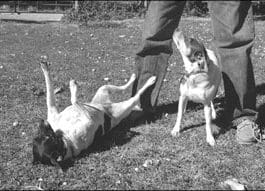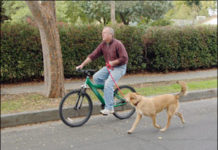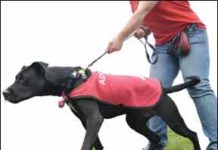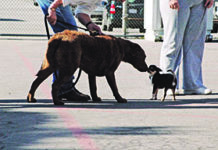Training Your Newly Adopted Dog
I have had a number of dogs over the years, but Otto is actually the very first dog that I’ve gotten as a co-owner. A former boyfriend paid the $40 or $50 that a Bodega, California, sheep rancher wanted for my heart/soul dog, Rupert, way back in 1989, but the puppy was a birthday present for me; Rupe was always my dog. He stuck close by my side through the breakup of that relationship and the next few, too. When Brian (the man who later became my husband) came on the scene, he and Rupert formed a bond, but still, Rupe was mine. Later, a summer of dog-sitting my sister Sue’s long-haired Chihuahua, Mokie, turned into a several-year stay. Mokie has since gone on to live with my sister Pam, who won’t ever give him up; Brian was more than happy when I did so. He tolerated Mokie, but never fully embraced the idea of a yappy little house-dog, no matter how smart and cute. So, while Brian and I have shared a home since 1996, we have never truly shared full ownership of a dog, like we do now. I selected Otto from a shelter, but Brian was the one who gave the signal that it was time for us to get a dog. When Brian and I got married, I kept my own last name, but Brian wanted to be sure that Otto took his surname, and even made sure the dog’s full name (“Otto Maddock”) was engraved on his ID tag. And Brian has been a real champ about sharing dog-care duties with me.
A Bond-Based Approach to Dog Training
There is a lot of food for thought in this book. There is much that I find intriguing and would like to pursue, and also much that I disagree with. Arnold criticizes modern trainers for their focus on operant conditioning without acknowledging the great interest force-free trainers have already demonstrated in regard to the concepts of empowerment, choice, and cognition in their training programs. She insists that dogs really are eager to please" their humans an idea I have long argued against. She hasn't convinced me on that topic
Debunking the “Alpha Dog” Theory
so he's trying it again.üIs this dog dominant or acting like an "alpha dog"? No; he's been trained to jump up and bite on cue."
New to Positive Dog Training?
Switching to positive training? At first, it might be frustrating for you – and your dog. The benefits, however, will last a lifetime. In positive training, the goal is to help the dog do the right thing and then reward him for it, rather than punishing him for doing the wrong thing. If he makes a mistake, the behavior is ignored, or excused with an “Oops, try again!” to encourage the dog to do something else.
Tail-Wagging Training
Training, says Massachusetts dog trainer Donna Duford, should be fun, not work. Her seminars are such upbeat, tail-wagging events that the dogs seem to be having a party. Look closer and you’ll see a serious class, with participants taking notes as Duford reviews the laws of learning and defines classical conditioning, operant conditioning, positive and negative reinforcement, positive and negative punishment, continuous and variable reinforcement schedules, and other fundamentals of behavioral training.
5 Professional Dog Training Tips
Yes, raising and training a puppy takes work, but it doesn't need to feel overwhelming at least, not the majority of the time! The more you know, the easier it gets. As I think about my own approach to raising and living with dogs, and that of many of my colleagues, I realize we engage in numerous behaviors that are extraordinarily helpful yet it's often difficult to get the pet owners we work for to try them! Don't resist! The following five tips can help you train like a pro.
Training Tiny Dogs
however.üMany small dogs reflexively resist being picked up
The 7 Habits of Highly Effective Dog Owners
but finds it even more rewarding to teach their owners how to build a better relationship with their canine family members
Comfort Your Dog
There is absolutely no evidence, not one bit, suggesting that providing comfort and security to a distressed dog causes the dogs anxiety or fear to increase. Why then, does this myth persist among dog owners and even with some trainers? Why are owners still advised to ignore their dog when he is distressed or anxious or fearful, as if providing any attention to the dog will reinforce those emotions?
The ABCs of Training
We have Edward Thorndike (1874 - 1949) to thank for teaching us about The Law of Effect. While studying behaviorism, he observed and described The Law of Effect, which states that behaviors change as a result of the consequences to actions. Boundless.com has a nice succinct explanation of The Law of Effect:
Dog Training Basics: How to Teach a Cue
While our dogs are born with all sorts of natural canine inclinations – like searching out food, investigating scents, romping with friends – “listen to words from humans” is not part of their default program. With the right kind of teaching, responding to your cues will become a dog’s go-to choice because it is the most reliable route to the things he wants.
How Much Training Does Your Dog Really Need?
Teaching a dog new behaviors can be lots of fun, and there are tons of people and dogs who thoroughly enjoy daily training and engaging in various canine sports or activities. However, it's equally important to give yourself permission to take the pressure off of yourself and your dog if training doesn't go so smoothly. By taking time to get to know your dog's personality, you will come to realize that your dog has a lot of strengths. We can spend so much time focusing on what is wrong with a dog, that we stop noticing what is right.
















